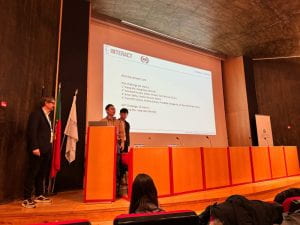In our recent blog we feature Jiteng Ma, who began his journey at SWAN as a PhD student and has since risen to the position of Senior Research Associate within the team. Jiteng shares insights into his research development within SWAN, his pivotal role within the team, and the significance of his work as a cornerstone output for the project.
What are your main research tasks within SWAN and how do these relate to your previous research experience?
 I joined SWAN at its inception, transitioning from completing my PhD to becoming a senior research associate. My main focus is on developing advanced secure communication transmitters, a role shaped by my involvement in the project.
I joined SWAN at its inception, transitioning from completing my PhD to becoming a senior research associate. My main focus is on developing advanced secure communication transmitters, a role shaped by my involvement in the project.
My research tasks include designing a new paradigm of the radio frequency (RF) power amplifier (PA) structure called digital power amplifier. In this innovative structure, multiple PAs are parallelised, introducing a digital control system that affords the designation ‘digital PA’ due to its increased degree of freedom. The primary design objective was to maximise power efficiency, ensuring each PA operates at peak efficiency, with the ability to control the system by selectively switching on/off multiple PAs. We also successfully developed an ultra-fast control circuit, enabling PA switching in less than one nanosecond. This work enhances the flexibility of the transceiver system, allowing it to adapt to various situations, such as working across different frequency bands.
Throughout the PA development, I encountered a significant challenge in the design of the output power combiner. Leveraging machine learning (ML) technologies, I sought to expedite the design process. I proposed a cascaded ML structure, training an inverse design model, with the capability of instantaneous design. While the ML models I developed and described in my published articles may not directly used in real-world microwave circuit design due to certain performance limitations, these endeavours provided invaluable insights to me.
What motivated you to pursue this particular area of research?
I am thrilled to embark on a journey into uncharted territory. It’s clear that artificial intelligence (AI) and ML are rapidly changing our world. The SWAN project has immense potential to utilise state-of-the-art ML technologies in regulating and programming microwave circuits. I am excited to witness how we can revolutionise the development of microwave and wireless communication systems using these technologies. Additionally, I am seeking further funding opportunities to continue the work in this field beyond the completion of the SWAN project.
Can you give us a brief overview of the work you have been doing recently and how this relates to the SWAN Prosperity Partnership?
I am working on an article to present an overview of microwave circuit design aided by ML. These technologies hold significant promise to enable the hardware agility of the communication system. To realise the agility of the output power combiner, I am collaborating with an MSc student to explore the design of a reconfigurable filter. Upon the completion of this project, I plan to integrate these technologies and contribute to the development of a prototype for an ML-enabled transmitter system. The SWAN project focuses on security and agile wireless communication, my role is pivotal as I strive to design an agile transmitter specifically tailored for the project’s needs, thereby making my contribution integral to its success. I have also spent some time working on developing ML models for accurate positioning systems, which is also related to the SWAN topic since knowing the accurate position of the receivers is critical for secure communications.
Where does this work fit in with SWAN’s wider Research Challenges?

A key challenge for the SWAN project is to realise secure agile transmitter. My focus is on enabling agile and high-performance transceiver architectures, which directly aligns with the project’s objective of introducing agility to the transceiver. In this context, the ML model serves as a central element of the control system. Additionally, other technologies such as digital PA architectures, programmable circuits, and linearity enhancement methods are equally vital in achieving our objectives.
Have there been any unexpected findings or challenges in your research?
Yes, from my personal experience, research is often harder than expected. There are quite a few challenges to my research, for example the simulation result is far from the real design. To solve this type of issue always requires a long time and experience. The linearity of the proposed digital PA is also a great challenge. We are currently working on multiple methods to develop high-performance digital predistortion systems to linearise the performance of digital PA system.
Are there any potential real-world applications or implications of your research?
Yes, the motivation and primary objective of my research are to make a tangible impact on real-world applications. For instance, the digital PA system we proposed in the project holds potential for application in agile wireless communication systems, particularly for addressing security concerns. Additionally, we aim to develop high-performance ML toolboxes to expedite the design process for RF engineers and researchers. However, it’s important to acknowledge that realising the full impact of these technologies in real life will require further time and endeavours.
How have SWAN’s partners in industry and government been involved in this work package?
I am a fully funded PhD student by the SWAN partner Toshiba. Toshiba offered me a lot of support during my career. Their guidance is precious to improve the quality of my research. Based on the platform of the SWAN, I often have a chance to present my work and demonstrate the testbeds. Luckily, I always got some useful feedback from the discussion. I also joined a few conferences and meetings to promote our research outcomes.
What are the next steps for this section of research?
The next step for agile transmitter research is to develop reconfigurable filters and agile transmitters powered by ML technologies. I will aim to improve the performance of the ML model to aid the microwave circuits design. We will design a better design template and use more powerful ML models like graph neural networks and Transformers. There is some other potential work on joint communication and sensing since the agility of the transmitter can be used for simultaneously accurately positioning and communicating with the receivers.
Is there anything else you would like to tell us?
 I recently attended a COST student competition alongside Mr. Liang Qiao, aimed at addressing communication challenges using deep neural network. COST is the European Cooperation in Science and Technology, which runs an EU-funded programme that enables researchers and innovators to set up their research networks in a wide range of scientific topics. The first challenge is on the PHY layer, in which we focus on ML-based direct indoor localisation using massive MIMO CSI measurements. The second challenge is on the NET layer, which focuses on performing calibrated probabilistic regression of the uplink throughput based on the observation of a set of KPIs. We were pleased to rank at the top of the leaderboard for both challenges. Additionally, we summarised our work in a conference paper, which has been accepted for presentation at IEEE WCNC 2024.
I recently attended a COST student competition alongside Mr. Liang Qiao, aimed at addressing communication challenges using deep neural network. COST is the European Cooperation in Science and Technology, which runs an EU-funded programme that enables researchers and innovators to set up their research networks in a wide range of scientific topics. The first challenge is on the PHY layer, in which we focus on ML-based direct indoor localisation using massive MIMO CSI measurements. The second challenge is on the NET layer, which focuses on performing calibrated probabilistic regression of the uplink throughput based on the observation of a set of KPIs. We were pleased to rank at the top of the leaderboard for both challenges. Additionally, we summarised our work in a conference paper, which has been accepted for presentation at IEEE WCNC 2024.
